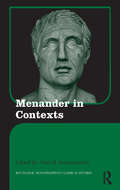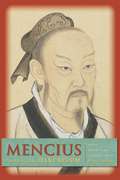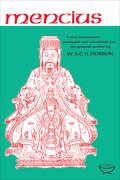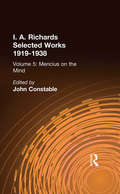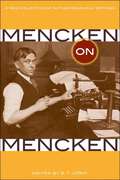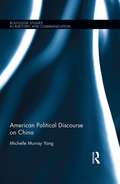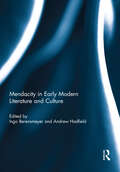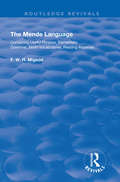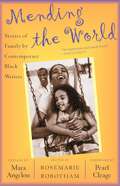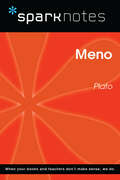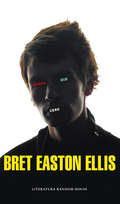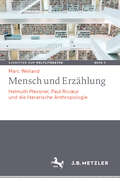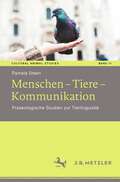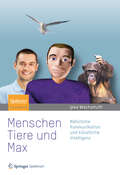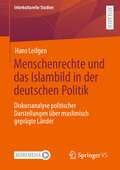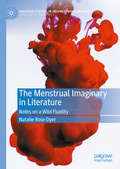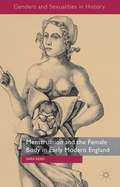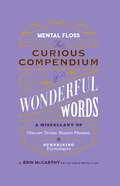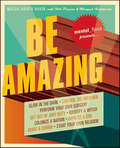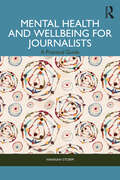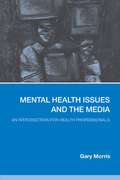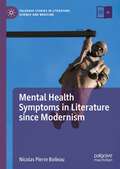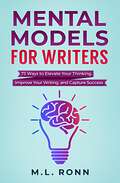- Table View
- List View
Menander in Antiquity
by Sebastiana NervegnaThe comic playwright Menander was one of the most popular writers throughout antiquity. This book reconstructs his life and the legacy of his work until the end of antiquity employing a broad range of sources such as portraits, illustrations of his plays, papyri preserving their texts and inscriptions recording their public performances. These are placed within the context of the three social and cultural institutions which appropriated his comedy, thereby ensuring its survival: public theatres, dinner parties and schools. Dr Nervegna carefully reconstructs how each context approached Menander's drama and how it contributed to its popularity over the centuries. The resultant, highly illustrated, book will be essential for all scholars and students not just of Menander's comedy but, more broadly, of the history and iconography of the ancient theatre, ancient social history and reception studies.
Menander in Contexts: Menander In Contexts (Routledge Monographs in Classical Studies #16)
by Alan H. SommersteinThe comedies of the Athenian dramatist Menander (c. 342-291 BC) and his contemporaries were the ultimate source of a Western tradition of light drama that has continued to the present day. Yet for over a millennium, Menander’s own plays were thought to have been completely lost. Thanks to a long and continuing series of papyrus discoveries, Menander has now been able to take his place among the major surviving ancient Greek dramatists alongside Aeschylus, Sophocles, Euripides and Aristophanes. In this book, sixteen contributors examine and explore the Menander we know today in light of the various literary, intellectual, and social contexts in which his plays can be viewed. Topics covered include: the society, culture, and politics of his generation; the intellectual currents of the period; the literary precursors who inspired Menander (or whom he expected his audiences to recall); and responses to Menander, from his own time to ours. As the first wide-ranging collective study of Menander in English, this book is essential reading for those interested in ancient comedy the world over.
Menander, New Comedy and the Visual
by Antonis K. PetridesThis book argues that New Comedy has a far richer performance texture than has previously been recognised. Offering close readings of all the major plays of Menander, it shows how intertextuality - the sustained dialogue of New Comedy performance with the diverse ideological, philosophical, literary and theatrical discourses of contemporary polis culture - is crucial in creating semantic depth and thus offsetting the impression that the plots are simplistic love stories with no political or ideological resonances. It also explores how the visual aspect of the plays ('opsis') is just as important as any verbal means of signification - a phenomenon termed 'intervisuality', examining in particular depth the ways in which the mask can infuse various systems of reference into the play. Masks like the panchrēstos neaniskos (the 'all-perfect youth'), for example, are now full of meaning; thus, with their ideologically marked physiognomies, they can be strong instigators of literary and cultural allusion.
Mencius: The Great Learning, The Doctrine Of The Mear [i. E. Mean] Confucian Analects [and] The Works Of Mencius (Translations from the Asian Classics)
by MenciusKnown throughout East Asia as Mengzi, or "Master Meng," Mencius (391-308 B.C.E.) was a Chinese philosopher of the late Zhou dynasty, an instrumental figure in the spread of the Confucian tradition, and a brilliant illuminator of its ideas. Mencius was active during the Warring States Period (403-221 B.C.E.), in which competing powers sought to control the declining Zhou empire. Like Confucius, Mencius journeyed to one feudal court after another, searching for a proper lord who could put his teachings into practice. Only a leader who possessed the moral qualities of a true king could unify China, Mencius believed, and in his defense of Zhou rule and Confucian philosophy, he developed an innovative and highly nuanced approach to understanding politics, self-cultivation, and human nature, profoundly influencing the course of Confucian thought and East Asian culture.Mencius is a record of the philosopher's conversations with warring lords, disciples, and adversaries of the Way, as well as a collection of pronouncements on government, human nature, and a variety of other philosophical and political subjects. Mencius is largely concerned with the motivations of human actors and their capacity for mutual respect. He builds on the Confucian idea of ren, or humaneness, and places it alongside the complementary principle of yi, or rightness, advancing a complex notion of what is right for certain individuals as they perform distinct roles in specific situations. Consequently, Mencius's impact was felt not only in the thought of the intellectual and social elite but also in the value and belief systems of all Chinese people.
Mencius: A New Translation Arranged and Annotated for the General Reader
by W.A.C.H. DobsonMost educated Westerners are familiar with the thinkers and prophets who inform the Western spirit. But they are less familiar with the thinkers who have shaped the major oriental civilizations. The heirs of these ancient civilizations are now once again in the ascendant. We must understand the ways and thoughts that condition their conduct. The Works of Mencius provides an admirable insight into one of the streams of thought of the Chinese. Indeed, the perceptive reader might well find that some ideas he though were new and alien in the new China have familiar echoes in Mencius. This new translation, especially arranged and annotated with the general reader in mind, has been made in the light of recent philological research. It aims at rendering an Archaic Chinese original in a modern and unadorned prose, and is intended for the general reader who is otherwise unfamiliar with Chinese authors and desires to understand what Mencius is about without encumbering the text with footnotes and technical apparatus which the specialist quite properly demands. While the text has been translated in its entirety its parts have been rearranged in a sequence which it is hoped will make them easier for the Western reader.
Mencius On The Mind: Experiments in Multiple Definition
by John ConstableFirst Published in 2001. Routledge is an imprint of Taylor & Francis, an informa company.
Mencken on Mencken: A New Collection of Autobiographical Writings
by H. L. Mencken S. T. Joshi"Mencken weighs 172 pounds, is 5 feet 10 inches in height and not beautiful. His chief amusement, after reading, is piano-playing, this he does very crudely. He takes no exercise except walking and is a moderate eater and drinker. He sometimes drinks as little as one bottle of beer a week, though this doesn't happen very often." So wrote H. L. Mencken about himself, in a brief sketch of his life penned in 1905.Perhaps America's foremost literary stylist and most mordant wit, Mencken's most engaging writing told about his own life and experiences. In Mencken on Mencken, veteran Mencken editor and scholar S. T. Joshi has assembled a hefty collection of the best of Mencken's autobiographical pieces that have not appeared previously in book form. These forty-four selections cover a wide variety of topics ranging from incidents from Mencken's everyday life to reflections on friends and colleagues to his careers as author, journalist, and editor, to his travels abroad. As a journalist in Baltimore, Mencken encountered many unusual characters: a professional mourner hired by a beer distiller, a wagon driver who slept through the great Baltimore fire of 1904, a confirmed bachelor who left town to avoid the clutches of a predatory widow. He provides accounts of literary figures he knew, such as Theodore Dreiser, and ruminations on his work at the Baltimore Sun and as editor for the magazines Smart Set and the American Mercury. In an essay titled "What I Believe," he eschews humor and writes straightforwardly of his longtime scorn for the idea of religion, and in his journalist mode he reflects on a half-century of attending political conventions, drawing on his vast inside knowledge to savage the corruption and incompetence of the political class. A superb travel writer, Mencken gives us a rollicking account of beer-drinking in Munich, astute observations of political unrest in Cuba, and carefully drawn scenes from a long tour he and his wife made of the Mediterranean in 1934.Joshi has thoroughly annotated the pieces and also compiled an extensive glossary of names and terms that Mencken mentions. Mencken on Mencken offers a fully rounded self-portrait of one of America's most colorful personalities and most extraordinary men of letters.
Mendacity and the Figure of the Liar in Seventeenth-Century French Comedy (Routledge Studies in Renaissance Literature and Culture)
by Emilia Wilton-GodberffordeThe first book-length study devoted to this topic, Mendacity and the Figure of the Liar in Seventeenth-Century French Comedy offers an important contribution to scholarship on the theatre as well as on early modern attitudes in France, specifically on the subject of lying and deception. Unusually for a scholarly work on seventeenth-century theatre, it is particularly alert to plays as performed pieces and not simply printed texts. The study also distinguishes itself by offering original readings of Molière alongside innovative analyses of other playwrights. The chapters offer fresh insights on well-known plays by Molière and Pierre Corneille but also invite readers to discover lesser-known works of the time (by writers such as Benserade, Thomas Corneille, Dufresny and Rotrou). Through comparative and sustained close readings, including a linguistic and speech act approach, a historical survey of texts with an analysis of different versions and a study of irony, the reader is shown the manifest ways in which different playwrights incorporate the comedic tropes of lying and scheming, confusion and unmasking. Drawing particular attention to the levels of communicative or mis-communicative exchanges on the character-to-character axis and the character-to-audience axis, this work examines the process whereby characters in the comedies construct narratives designed to trick, misdirect, dazzle, confuse or exploit their interlocutors. In the different incarnations of seducer, parasite, cross-dresser, duplicitous narrator/messenger and deluded mythomaniac, the author underscores the way in which the figure of the liar both entertains and troubles, making it a fascinating subject worthy of detailed investigation.
Mendacity in Early Modern Literature and Culture
by Ingo Berensmeyer and Andrew HadfieldMendacity in Early Modern Literature and Culture examines the historical, cultural, and epistemological underpinnings of lying and deception in early modern England, including the political, religious, aesthetic, and philosophical discourses that governed the codes of lying and truth-telling from the sixteenth to the early eighteenth centuries. The contributions to this collection draw on a wide range of early modern English literature from Shakespeare to Swift, and from travel writing to poetry, in order to explore the extent to which plays, poems, and narrative texts in this period were sites of negotiation, and, at times, of ideological warfare between the moral imperative of truth-telling and the expediency of telling lies. What were the cultural norms of truthfulness and lying, and on what basis were they constructed? What were the consequences when someone did not share the assumed common project of truth-telling? And which forms of communication were exempt from the pragmatic strictures on mendacious discourse? This book was originally published as a special issue of the European Journal of English Studies.
The Mende Language: Containing Useful Phrases, Elementary Grammar, Short Vocabularies, Reading Materials (Routledge Revivals)
by F.W.H. MigeodFirst published in 1908, this volume emerged in the midst of the British Protectorate of Sierra Leone. The author, F.W.H. Migeod, studied the Mende nation in eastern Sierra Leone and followed the example of the grammar (1882) and vocabulary (1884) published by Dr. Schoen in using the southern form of the Mende language. Beginning with an introduction to the recent history, culture and characteristics of the Mende nation and Sierra Leone, this volume covers useful phrases, grammar, vocabulary and example reading materials including stories and songs collected from native speakers.
Mending the World: Stories of Family by Contemporary Black Writers
by Rosemarie RobothamThe many facets of black family life have not always been fully visible in American literature. Black families have often been portrayed as chaotic, fractured, and emotionally devastated, and historians and sociologists are just beginning to acknowledge the resilience and strength of African American families through centuries of hardship. In Mending the World, a host of beloved writers celebrate the richness of black family life, revealing how deep, complicated, and joyous modern kinship can be. From Jamaica Kincaid's portrait of a young girl moving away from her mother to better know herself to Alice Walker's reflection on the joy and pain of her relationship with her own daughter; from Edwidge Danticat's fictional evocation of a young woman rocked by revelations about her parents to James McBride's elegy for his stepfather, this inspiring volume presents-through fiction, memoir, and poetry-a multi-layered and optimistic portrait of today's black America.
Meno (SparkNotes Philosophy Guide)
by SparkNotesMeno (SparkNotes Philosophy Guide) Making the reading experience fun! SparkNotes Philosophy Guides are one-stop guides to the great works of philosophy–masterpieces that stand at the foundations of Western thought. Inside each Philosophy Guide you&’ll find insightful overviews of great philosophical works of the Western world.
Menos que cero
by Bret Easton EllisClay regresa a Los Ángeles durante las vacaciones de Navidad. En el aeropuerto lo espera su novia Blair, por la que siente una profunda indiferencia. Un escueto mensaje de su madre sobre la mesa de la cocina y la nueva criada lo aguardan en casa. Enseguida intenta ponerse en contacto con Julian, su huidizo mejor amigo, que ha abandonado la universidad y coquetea con la heroína, pero no consigue encontrarlo. Sin nada mejor que hacer, se reincorpora a sus viejas rutinas: un frenesí de fiestas interminables, sexo sin miramientos y montañas de coca.Retrato de una sociedad en la que cada adolescente tiene su dealer y en la que las emociones se miden en fajos de billetes, Menos que cero es la primera novela del autor de American Psycho. Escrita cuando Bret Easton Ellis contaba solo veinte años, Menos que cero narra, con un estilo gélido y contundente, las andanzas de un grupo de adolescentes a la deriva en los años ochenta, y sorprendió a la crítica para convertirse inmediatamente en obra de culto.
Mensch und Erzählung: Helmuth Plessner, Paul Ricœur und die literarische Anthropologie (Schriften zur Weltliteratur/Studies on World Literature #9)
by Marc WeilandDer Mensch lebt von Natur aus in und mit Geschichten. Mit Erzählungen bestimmt er, als wer oder was er sich denkt und wer oder was er ist. Den damit verbundenen anthropologischen und subjektivitätstheoretischen Grundlagen und Funktionen des Erzählens geht die Untersuchung anhand einer systematischen Verschränkung der Philosophischen Anthropologie Helmuth Plessners mit der Erzähltheorie Paul Ricœurs sowie aktuellen literaturtheoretischen Ansätzen nach. Dabei zeigen Analysen zu Menschenbildern in Literaturen der (Post-)Moderne und Gegenwart, dass sich die jeweils vorgenommenen Bestimmungsversuche ebenso wie die wahrgenommenen Unergründlichkeiten auch auf die literarisch reflektierten Formen und Aneignungsweisen des Narrativen auswirken – und schließlich ein exzentrisches Erzählen erzeugen.
Menschen – Tiere – Kommunikation: Praxeologische Studien zur Tierlinguistik (Cultural Animal Studies #11)
by Pamela SteenDie Human-Animal Studies betrachten Mensch-Tier-Begegnungen aus interdisziplinären Perspektiven. Pragmalinguistische Zugänge fehlen jedoch bisher weitgehend. Das vorliegende Buch untersucht, wie Menschen und Tiere gemeinsam kommunikative Situationen gestalten und dabei interspezifische Naturkulturen hervorbringen. Der posthumanistische Ansatz sieht Menschen und Tiere als gleichwertige Akteur/innen und stützt sich auf praxisorientierte Ansätze, die auch körperlich realisierte Ko-Aktivitäten von Menschen und Tieren in den Blick nehmen. Der Band bietet damit eine umfassende theoretische und methodische Neuausrichtung einer Kulturlinguistik als Tierlinguistik.
Menschen, Tiere und Max
by Ipke Wachsmuth"Nur selten fragt die Wissenschaft nach dem roten Faden, der Lebendiges mit Technischem, Mensch mit Tier und beide mit Computern oder Robotern verbindet. Dieses lesenswerte Buch ist ein brillanter Führer durch den Themendschungel - und unerlässlich für jeden, der sich über den Stand der Forschung informieren will." Gert Scobel, 3sat"Was ist Kommunikation? Ein Pionier des digitalen Zeitalters nimmt uns mit auf eine spannende Reise: von Menschen und Tieren zu Computern und Robotern, die uns zunehmend ähneln und zugleich verändern und in Frage stellen. Wer sind wir, und wie werden wir künftig miteinander umgehen? Zugleich augenzwinkernd und tiefgründig und vor allem immer authentisch baut Ipke Wachsmuth beim Leser nicht nur Unwissen ab, sondern auch Ängste und Sorgen." Manfred Spitzer, Autor von "Lernen" und "Medizin für die Bildung"Wie gelingt Kommunikation? Unter welchen Voraussetzungen verstehen wir einander? Wie lernen Kleinkinder, sich zu verständigen? Wie kommunizieren Tiere untereinander und mit uns? Und schließlich: Können Roboter und virtuelle Agenten zu vertrauenswürdigen und einfühlsamen Dialogpartnern und Helfern werden? Ipke Wachsmuth führt den Leser auf einen spannenden Streifzug durch die Vielfalt und Komplexität der kommunikativen Fähigkeiten. Immer wieder begegnet uns dabei Max, ein Kunstmensch aus der virtuellen Realität, an dem sich ganz konkret das Funktionieren von Kommunikation und Fragen über die Möglichkeiten künstlicher Intelligenz erörtern lassen. Aus dem Epilog: Ich erwache, weil Max mich ruft. Von der schimmernden Wand, die ein einziges riesiges Display ist und die hinter ihm nun das Tagespanorama von Seoul zeigt, begrüßt er mich mit fröhlichem Gesicht: "Guten Morgen, Ipke, acht Uhr! Ausgeschlafen? Du hast doch um zehn Uhr einen Termin." ... Jetzt aber los. Halt, wie war das noch mit der freundlichen Begrüßung? "Max? Wie sagt man nochmal ,Guten Tag' in Korea?" Max sogleich: "An-nyeong ha-se-yo", und weiter: "Du musst in einer Viertelstunde aufbrechen." Also doch noch Zeit für ein wenig Entspannung. "Max, gib mal etwas Musik." Er kennt ja meine Lieblingsstücke, aus meinem iTunes. Max wählt ein Bluesstück aus und tanzt dazu. Ich greife zum Couchtisch, wo meine Bluesharp liegt, und jamme etwas, variiere das eine oder andere, bis es richtig groovt. _____ Möwen, Krabben und Marktschreier - ausgehend von Alltagsbeobachtungen beleuchtet Ipke Wachsmuth in diesem Buch die Themen Kommunikation, natürliche und künstliche Intelligenz. Es geht dabei um Sprache und Denken, um Mimik und Gestik - und um die Komplexität hinter den so alltäglich erscheinenden kommunikativen Fähigkeiten von Menschen und Tieren. Das Buch führt auch in die Welt von Robotern und anderen künstlichen Wesen ein, die unseren künftigen Alltag mehr und mehr bevölkern werden. Max ist ein "lebendes" Beispiel dafür, wie die Schnittstelle zwischen Mensch und Computer in Zukunft aussehen könnte. Doch wie erzeugt man ausdrucksvolle Sprache? Wie lassen sich Gesichtsausdrücke technisch nachahmen? Welche Rolle spielt der Sprechrhythmus für unsere Kommunikation? Wie ist die hochentwickelte Wortsprache des Menschen entstanden, die uns von allen Tieren unterscheidet? Bildgebende Verfahren machen es heute möglich, dem Hirn beim Denken "zuzuschauen" und damit auch Einblicke in die Prozesse des Sprachverstehens zu erlangen, die man mit künstlicher Intelligenz nachzuahmen versucht. Zu den weiteren Themen des Buches gehören Gebärdensprachen, der Zusammenhang von Zeichen und Bedeutung sowie die Wirkung von spontanen Körperbewegungen und Körperhaltung für die Übermittlung von Botschaften. Spannend ist die Frage, inwieweit Tiere und Menschen sich über Bedeutsames austauschen können. Sind Menschenaffen in der Lage, Symbole zu gebrauchen und absichtsvoll zu kommunizieren, verfügen sie vielleicht sogar über Bewusstsein? Und wird sich ein Maschinenwesen wie Max eines Tages mit uns aus der Perspektive eines eigenen "Ich" unterhalten können? Maschinen mit "Eigenleben" - kann es und soll es die geben? Könnten sie einfühlsame Partner des Menschen werden...
Menschenrechte und das Islambild in der deutschen Politik: Diskursanalyse politischer Darstellungen über muslimisch geprägte Länder (Interkulturelle Studien)
by Hans LeifgenPolitische Berichte und menschenrechtliche Debatten prägen das Islambild in Deutschland mit. Die vorliegende Forschungsarbeit setzt sich exemplarisch mit der Menschenrechtsberichterstattung der politischen Fraktionen im Deutschen Bundestag über muslimisch geprägte Länder auseinander. Im Zentrum des Interesses stehen dabei die Fragen, wie die Menschenrechtslage in muslimisch geprägten Ländern dargestellt und welcher menschenrechtliche Bezugsrahmen verwendet wird sowie, welche Rolle die Religion Islam bei der Berichterstattung spielt. Hierzu werden die diskurstheoretische Perspektive Foucaults (1981) und der forschungsmethodische Zugang der Kritischen Diskursanalyse Jägers (2015) herangezogen. Ziel der Forschung ist, exemplarische Erkenntnisse über potenzielle gesamtgesellschaftliche Auswirkungen der Berichterstattung – insbesondere auf das Islambild in Deutschland – zu erhalten. Daher untersucht die Arbeit, wie bei der Berichterstattung Wirklichkeit konstruiert wird.
The Menstrual Imaginary in Literature: Notes on a Wild Fluidity (Palgrave Studies in (Re)Presenting Gender)
by Natalie Rose DyerThis book draws on literary, cultural, and critical examples forming a menstrual imaginary—a body of work by women writers and poets that builds up a concept of women’s creativity in an effort to overturn menstrual prejudice. The text addresses key arbiters of the menstrual imaginary in a series of letters, including Sylvia Plath the initiator of ‘the blood jet’, Hélène Cixous the pioneer of a conceptual red ink and the volcanic unconscious, and Luce Irigaray the inaugurator of women’s artistic process relative to a vital flow of desire based in sexual difference. The text also undertakes provocative against-the-grain re-readings of the Medusa, the Sphinx, Little Red Riding Hood, and The Red Shoes, as a means of affirmatively and poetically re-imagining a woman’s flow. Natalie Rose Dyer argues for re-envisioning menstrual bleeding and creativity in reaction and resistance to ongoing and problematic societal views of menstruation.
Menstruation and the Female Body in Early Modern England
by Sara ReadIn early modern English medicine, the balance of fluids in the body was seen as key to health. Menstruation was widely believed to regulate blood levels in the body and so was extensively discussed in medical texts. Sara Read examines all forms of literature, from plays and poems, to life-writing, and compares these texts with the medical theories.
Mental Floss: A Miscellany of Obscure Terms, Bizarre Phrases & Surprising Etymologies
by Erin McCarthy Mental FlossEver wonder if there is a synonym for the word synonym? Or why people really hate the word &“moist?&” Maybe you want to know why we tell a person to take something &“with a grain of salt,&” or why McDonalds went to war with a dictionary. From obscure words to the best literary insults ever written, this linguistic miscellany is sure to spice up your vocabulary, make you a whizz at word games, and prepare you for plenty of wordy repartee for your next soiree, with some of the most bizarre terms you never knew you needed. A CACOPHONY OF WORDS: Learn the meaning and surprising history of hundreds of words and phrases LOTS OF LISTS: Discover curated collections of literary insults, old-timey words, popular slang, and much more WORD GAME WIZ: Includes tips for mastering popular word games from Scrabble to Wordle WIT FOR WRITERS: Writers looking for just the right word will be inspired by hundreds of unusual and obscure words REFERENCE FOR READERS: Fans of every genre, from Norse Myths to Victorian Romance will find histories, origins, and backstories of the words that make up their favorites reads COMPLETE YOUR COLLECTION: Mental Floss: The Curious Reader, Mental Floss: The Curious Movie Buff, and Mental Floss: The Curious Viewer are also available.
Mental Floss Presents Be Amazing: Glow In The Dark, Control The Weather, Perform Your Own Surgery, Get Out Of Jury Duty, Identify A Witch, Colonize A Nation, Impress A Girl, Make A Zombie, Start Your Own Religion
by Will Pearson Mangesh Hattikudur Maggie Koerth-BakerBe amazingWho says you can't? It's time to get off the couch and take your life to the next level.Step one: stand on the shoulders of geniusesWhat good are the world's greatest geniuses if you can't muddy their shoulder pads and use their accomplishments as a step stool? mental_floss has combed through every success story in history to deliver this ultimate how-to guide for climbing your way to greatness.Step two: bask in the glow of admiring fansWhether you want to glow in the dark, swallow a sword, quit smoking, find Atlantis, live forever, get out of jury duty, buy the Moon, sink a battleship, stop global warming, become a ninja, or simply be the center of the universe, Be Amazing covers all the essential life skills. Just absorb a few pages, then let the hero worship begin!You will need: A hunger for greatnessSome duct tapeThis bookYou may want:Sidekicks and/or minionsAn impressive nicknameAn amazing outfit
Mental Health and Wellbeing for Journalists: A Practical Guide
by Hannah StormThis book offers a first-of-its-kind, practical and person-centred guide to managing and contextualising journalists’ emotional wellbeing and mental health.Drawing on the author’s experience as a storyteller, journalist and media safety consultant, the book combines significant lived personal experience with reflections from an international network of journalists and mental health experts to collate industry good practice and guidance. It takes readers through a history of mental health discussions in the industry, moving from a focus on war correspondents and post-traumatic stress disorder to considerations of vicarious trauma, moral injury and the impact of online harm on journalists. It shows how pressures already faced by those in the sector have been exacerbated by the global pandemic, giving rise to the prospect of a mental health crisis in the media if these issues remain unaddressed. As a counter to this concern, Storm shares insights from experts on what leaders can do to create safer workplaces and processes, how they can channel the empathy that is core to healthy journalism to promote the health of its people, and how they should consider mental health as intersecting with other issues such as physical safety, diversity and inclusion. Insights from science shed light on resilience levels, how our brains and bodies respond to trauma, and strategies that can be adopted to help us recover from challenging experiences. While acknowledging that some news organisations are starting to take note, Storm shows how others need to do more, offering ways in which newsrooms can learn from the lessons of recent years to bring about long-lasting change.Mental Health and Wellbeing for Journalists is written for news media professionals, educators, and students, as well as anyone interested in promoting more sustainable journalism through supporting the industry’s most precious resource: its people.
Mental Health Issues and the Media: An Introduction for Health Professionals
by Gary MorrisMental Health Issues and the Media provides students and professionals in nursing and allied professions, in psychiatry, psychology and related disciplines, with a theoretically grounded introduction to the ways in which our attitudes are shaped by the media. A wide range of contemporary media help to create attitudes surrounding mental health and illness, and for all health professionals, the ways in which they do so are of immediate concern. Health professionals need to: be aware of media influences on their own perceptions and attitudes take account of both the negative and positive aspects of media intervention in mental health promotion and public education understand the way in which we all interact with media messages and how this affects both practitioners and service users. Covering the press, literature, film, television and the Internet, this comprehensive text includes practical advice and recommendations on how to combat negative images for service users, healthcare workers and media personnel.
Mental Health Symptoms in Literature since Modernism (Palgrave Studies in Literature, Science and Medicine)
by Nicolas Pierre BoileauThe Function of Symptoms in British Literature since Modernism looks at various ways of treating symptoms of psychological disorders in the literature of the long twentieth century. This book shows that literature can, in its questioning of commonly accepted views of this lived experience of psychic symptoms, help engender new theories about the functioning of subjective cases. Modernism emerged at about the same time as Freudian psychoanalysis did and the aim of this book is to also show that to a certain extent, Woolf preceded Freud in her exploration of the symptom and contributed to fashioning another approach that is now more common, especially in writers from the 1990s-onwards.
Mental Models for Writers: 73 Ways to Elevate Your Thinking, Improve Your Writing, and Capture Success (Author Level Up #4)
by M.L. RonnThe world’s smartest people use these secrets to 10x their success and make more money—and you can, too! Do you wish you knew the unwritten rules to being a successful writer—you know, the things that no one will ever tell you? Mental models are the unwritten rules of success. Used in fields like science, engineering, and economics, mental models have guided important people for centuries... It's only in the last few decades that these secrets have been “unmasked” by successful businessmen like Warren Buffet and Charlie Munger. But many people still don't know about them... In this writer’s guide, prolific writer M.L. Ronn taps into the mysterious world of mental models, frameworks for thinking that will revolutionize the way you approach every aspect of the writing life.This is the only mental model book on the market written specifically for writers! Win big with your writing by applying strange yet curiously effective ideas from mega thinkers like Plato, Sir Isaac Newton, and more Solve every writing problem effortlessly (including writer’s block!) Collect unfair advantages in every area of the writing life, including creativity, fiction writing, and business Transform your marketing & promotion using the laws of persuasion In today’s new world of publishing, the world and all of its riches belong to the writers who dare to elevate their thinking and blaze new paths. Are you willing to learn what it takes to join the world's most successful writers and thinkers? Click the buy button to download your copy of Mental Models for Writers today! V1.0

